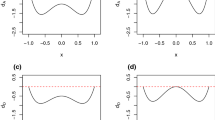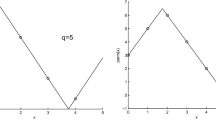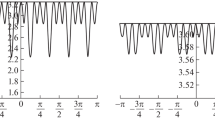Abstract
This article considers universal optimality of digital nets and lattice designs in a regression model. Based on the equivalence theorem for matrix means and majorization theory, the necessary and sufficient conditions for lattice designs being φ p - and universally optimal in trigonometric function and Chebyshev polynomial regression models are obtained. It is shown that digital nets are universally optimal for both complete and incomplete Walsh function regression models under some specified conditions, and are also universally optimal for complete Haar wavelet regression models but may not for incomplete Haar wavelet regression models.
Similar content being viewed by others
References
Pukelsheim F. Optimal Design of Experiments. New York: Wiley, 1993
Bate R A, Buck R J, Riccomagno E, et al. Experimental design and observation for large systems. J Roy Statist Soc Ser B, 58: 77–94 (1996)
Kiefer J, Wolfowitz J. Optimum designs in regression problems. Ann Math Statist, 30: 271–294 (1959)
Riccomagno E, Schwabe R, Wynn H P. Lattice-based D-optimum design for Fourier regression. Ann Statist, 25: 2313–2327 (1997)
Arnold B C. Majorization and the Lorenz Order: A Brief Introduction. Berlin: Springer-Verlag, 1987
Marshall A W, Olkin I. Inequalities: Theory of Majorization and Its Applications. New York: Academic Press, 1979
Bondar J V. Universal optimality of experimental designs: definitions and a criterion. Canad J Statist, 11: 325–331 (1983)
Mason J C, Handscomb D C. Chebyshev Polynomials. Florida: Chapman & Hall/CRC, 2003
Kiefer J, Studden W J. Optimal designs for large degree polynomial regression. Ann Statist, 4: 1113–1123 (1976)
Lim Y B, Studden W J. Efficient D s-optimal designs for multivariate polynomial regression on the q-cube. Ann Statist, 16: 1225–1240 (1988)
Niederreiter H. Random Number Generation and Quasi-Monte Carlo Methods. CBMS-NSF Regional Conference Series in Applied Mathematics. Philadelphia: SIAM, 1992
Hickernell F J, Dick J. An algorithm-driven approach to error analysis for multidimensional integration. Int J Numer Anal Model, 5: 167–189 (2008)
Author information
Authors and Affiliations
Corresponding author
Additional information
This work was supported by National Natural Science Foundation of China (Grant No. 10671007), National Basic Research Program of China (Grant No. 2007CB512605), Hong Kong Research Grants Council (Grant No. RGC/HKBU/2030/99P), Hong Kong Baptist University (Grant No. FRG/00-01/II-62), and US National Science Foundation (Grant No. NSF-DMS-0713848)
Rights and permissions
About this article
Cite this article
Ai, M., Hickernell, F.J. Universal optimality of digital nets and lattice designs. Sci. China Ser. A-Math. 52, 2309–2320 (2009). https://doi.org/10.1007/s11425-009-0171-y
Received:
Accepted:
Published:
Issue Date:
DOI: https://doi.org/10.1007/s11425-009-0171-y




